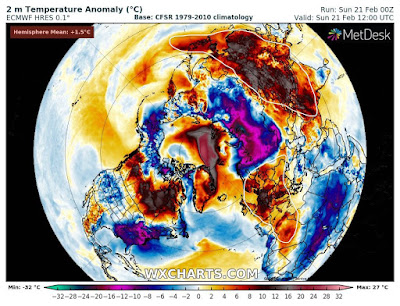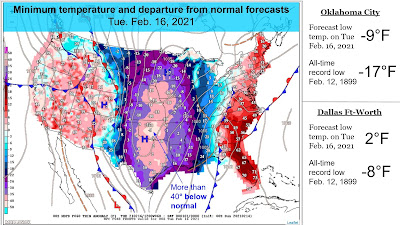 |
Interstate 35 in Austin, Texas took on a frozen post-
apocalyptic look this week. Photo by Miguel
Gutierrez Jr/Texas Tribune |
The United States certainly went through one hell of a week in the weather department, with extreme, deadly weather that will be remembered for generations to come.
This incredible weather will wane and things are slowly starting to go back to something resembling normal, but the damage is done.
The death toll is rising, and there will probably be billions of dollars in damage from coast to coast.
As of Wednesday, the nationwide death toll from the Arctic weather had risen to at least 30, and that will surely go up, possibly a lot, as people are found in frozen homes and apartments. By some estimates, this will be the most expensive weather disaster in Texas history, costing even more than the $20 billion in inflation-adjusted damage from Hurricane Harvey in 2017.
Now that the weather is finally getting ready to slowly improve, here's how this all happened in the first place:
THE METEOROLOGY
This episode of awful weather had it seeds in what I described in this blog thingy a month ago. A sudden stratospheric warming.
Way back on January 9, I described how this sudden stratospheric warming would blow the polar vortex apart. The vortex is a huge upper level pool of frigid, stormy air that usually hangs out somewhere in the Arctic. It does tend to move around somewhat.
Or, as noted get blown apart occasionally.
We're reaping that harvest, as it were, of that event now.
This disrupted polar vortex led to something called high latitude blocking, which is basically high pressure areas setting up around the Arctic. Pieces of the polar vortex, which is low pressure, were displaced further south
As the Washington Post Capital Weather Gang explains it, this high pressure in the high Arctic helped displace the polar vortex into the North Atlantic. The low pressure in the North Atlantic and high pressure near Alaska channeled incredibly bitter air from Siberia, across the North Pole and straight down into Canada and the United States.
The jet stream also became weaker than it normally is this time of year. A strong jet stream tends to keep most of the cold air bottled up in Canada.
A weaker jet stream has much more pronounced curves, dips and bumps. A big dip in this weak jet stream developed over the central United States, and that directed that awful Siberian air right down to Texas.
Outbreaks of Arctic air usually get shunted east, at least to an extent, so that the Great Lakes and Northeast shiver in temperatures way below zero. That's sort of OK, we're used to it.
This time, with that big dip in the jet stream, the frigid air shot straight to Oklahoma and Texas, with little chance to modify on the way down.
CLIMATE CHANGE?
I've seen a few wags online saying a record, intense cold wave like his is "proof" climate change does not exist.
As I always state, a single weather event does nothing to prove or disprove climate change.
The weather always has extremes, one way or the other. Climate change has loaded the dice, so it's now likely there will be hot spells than cold spells. But there will still be cold spells.
Actually, the air temperature at its source in Siberia and the Arctic wasn't unusual. What was strange is that it made its way all the way down to the Mexican border, resulting in the extreme cold for the South.
I've mentioned this before, but some scientists suspect that climate change can actually make these kinds of episodes more likely.
The Arctic is warming faster than points south, so that reduces the temperature contrast between the tropics and the poles. A subdued temperature contrast might make a weaker jet stream. Remember what I said above: A weaker jet stream can be more prone to bigger dips and ridges. That in turn, can pull cold air south where it doesn't belong and hot air north, where it also doesn't belong.
In fact, this is the second time in four months this has happened in the southern Plains. An out of season ice storm caused a lot of problems in Oklahoma back in October.
But as Nature reported last November, the science around climate change and weaker jet streams and weird spells of weather is still very iffy.
Scientists have a lot more work to do to establish whether these mega cold snaps amid an otherwise warming climate is a real thing or not.
THE ICE
While that polar vortex in the North Atlantic was helping direct frigid air into the United States, a stronger than average ridge of swarm, tropical high pressure in the upper atmosphere established itself off the Southeast United States coast, and north of the Caribbean.
This directed - or tried to direct - warm, humid air toward the southeastern United States. Note that while most of the nation was freezing, Florida was enduring near record winter time heat and humidity.
Warm air is lighter than cold air. When this toasty, humid air encountered the frigid air over much of the United States, it would ride up and over the cold air. And there were plenty of episodes in the past week where this happened, and is still happening.
Raindrops falling from the warm air encounter the cold air near the surface. They either freeze on the way down, creating sleet, or freeze on contact with the ground, causing the dangerous and damaging icing we've seen so much of.
TEXAS POWER OUTAGES
Politics over the widespread and dangerous Texas power outages as exploded.
The outages, which affected more than 4 million Texans, is the most serious and probably most deadly outcome of this cold snap.
 |
Electrical grids froze up all over Texas, leading
to massive days-long blackouts |
Texas is used to heat waves, but cold waves of this intensity and length are super rare. The whole state was affected, not just part of it as is typical in most winter cold snaps.
This has probably happened maybe four or five times in the past 200 years or so.
Demand for power spiked as people struggle to heat their homes.
If you figure a comfortable temperature for a house is 70 degrees, you only have to cool the rooms by 30 degrees if its hot outside in the summer
In this cold wave you have to heat the rooms by 70 degrees if it's zero outside so that takes a lot of energy. Plus, the millions of homes and businesses in Texas are designed to be insulated from New England-style winter conditions.
The gas and coal plants weren't up to the task. Plus, these plants were not built to withstand such bitter temperatures. Gas lines froze, as did equipment in power plants.
Most of the nation's power is controlled by two massive grids, one in the eastern half of the nation, one in the west.
Since each power grid encompasses several states, they are subject to federal regulations that, among other things, demand that the plants are weatherized. Also, since the east and west grids are so big, they can be some electricity trading with other states if one area is affected by bad weather and another is not.
Texas, however, controls its own power grid, controlled by the now-unfortunately named Electric Reliability Council of Texas, or ERCOT.
The Texas power grid is not part of the eastern and western regions. They've done this in part to avoid dealing with cumbersome federal regulations. The state didn't winterize their power plants, because cold waves like this are so rare.
When the weather hit, the plants wilted in the Arctic chill. Compounding the problem, some electricity generating plants shut down in Texas during the winter for maintenance. That's because electricity demand in the Lone Star State is usually highest in the summer.
I've seen some blame go to wind and solar power that froze up in the cold. But these renewables only contribute 21 percent of Texas electricity generation.
Some wind turbines did freeze up, but most of them kept working. Though power from windmills did decrease during the winter storm, that decrease from renewables was actually a little less than forecast. Most of the problem was from gas and coal electric generating plants.
By the weekend, temperatures in Texas will rise to levels near or even a little above average for the season - well above freezing. The power will come back on for everybody. All those frozen pipes will thaw, causing countless new building floods, drinking water shortages and danger.
It will take many areas of the nation awhile to recover from this disaster. That's especially true in Texas.


























